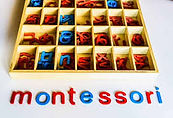License # 344501313
Curriculum
In a Montessori classroom, children use Montessori materials for hands-on exploration and self-correction. They experience individualized learning tailored to their interests and abilities. The mixed age groups environment allows older children to become mentors, while younger children admire them and seek inspiration, promoting collaboration. With freedom and responsibility, children choose their activities, fostering decision-making skills. The prepared environment is organized and accessible, supporting independent exploration. This approach nurtures holistic development, addressing emotional, social, physical, and cognitive growth. Here are the key components of a Montessori curriculum:
Practical Life

Activities that help children develop life skills, such as pouring, sweeping, and caring for the environment. These tasks promote independence, coordination, and concentration.
Sensorial

Materials designed to help children refine their senses, including touch, sight, sound, taste, and smell. Children explore concepts such as texture, color, shape, and volume through hands-on experiences.
Mathematics

Concrete materials that introduce mathematical concepts, such as counting, addition, subtraction, and geometric shapes. This approach helps children grasp abstract concepts through manipulation and exploration.
Language

Activities that build vocabulary, phonemic awareness, reading, and writing skills. Children learn through storytelling, language games, and engaging with a variety of literature.
Cultural

Exploration of geography, history, science, and the arts. This area encourages children to develop an understanding of the world, its diverse cultures, and the interconnectedness of all living things.